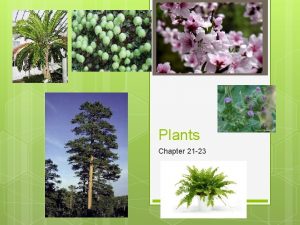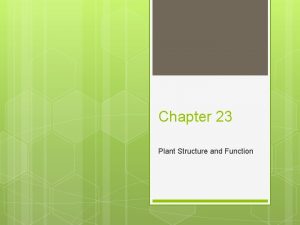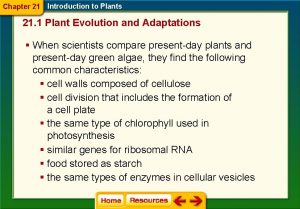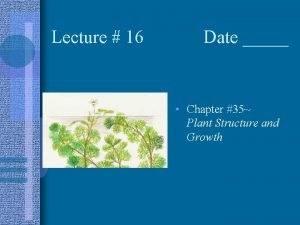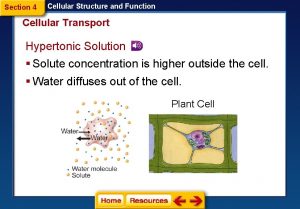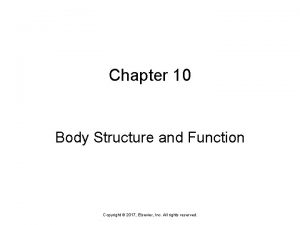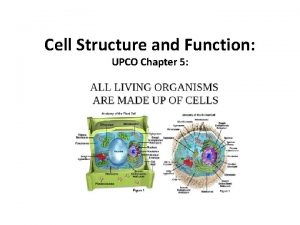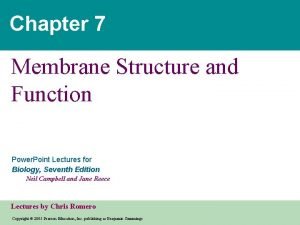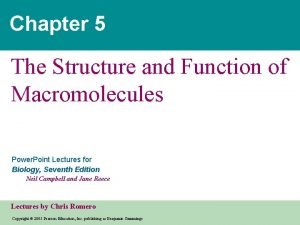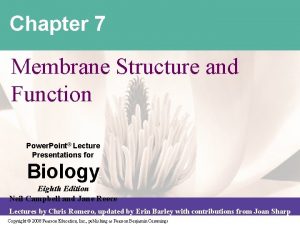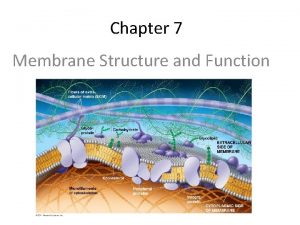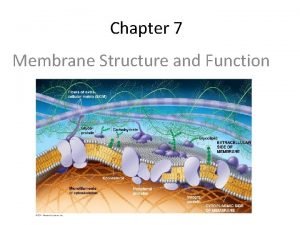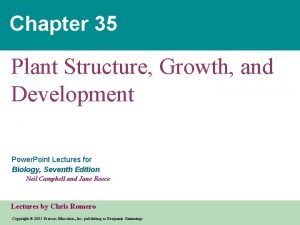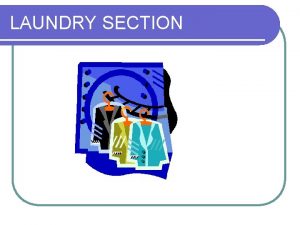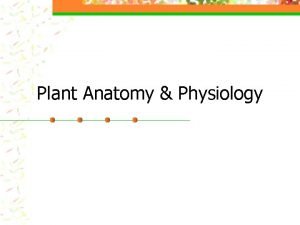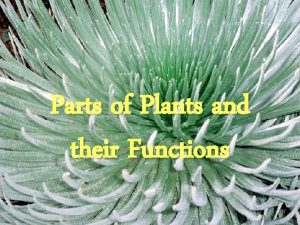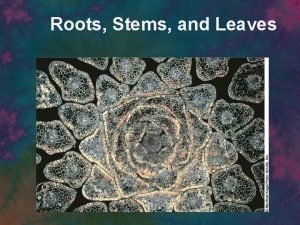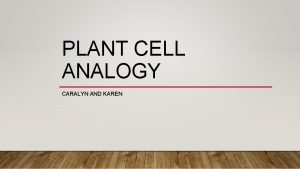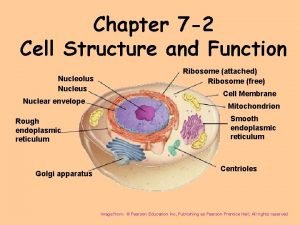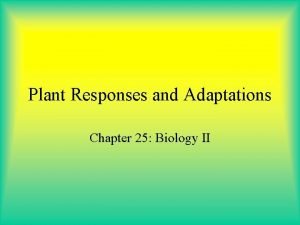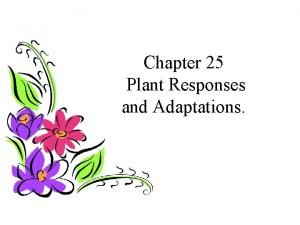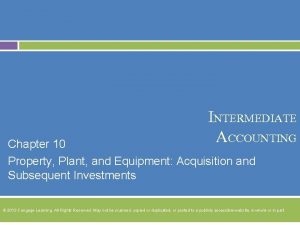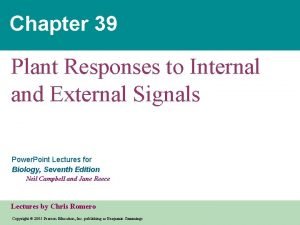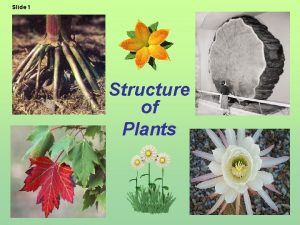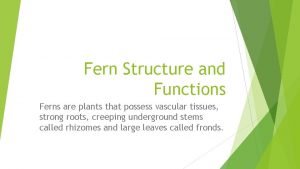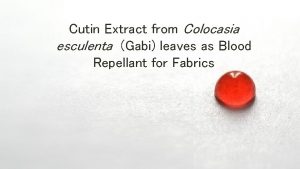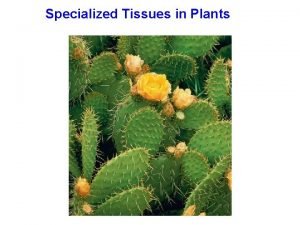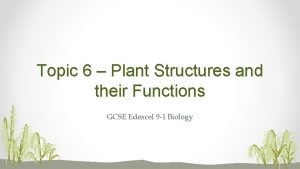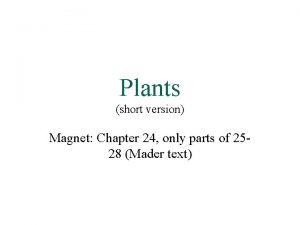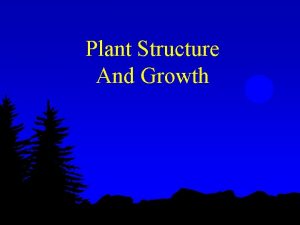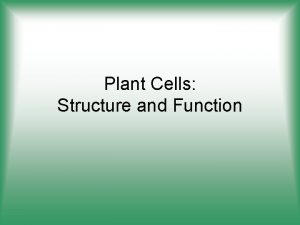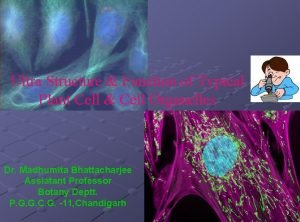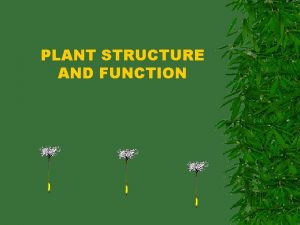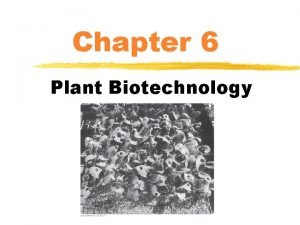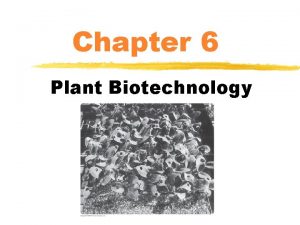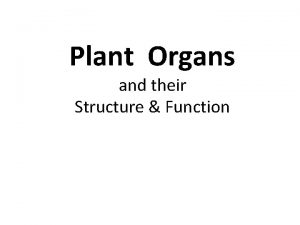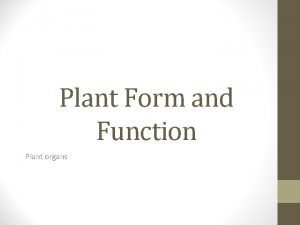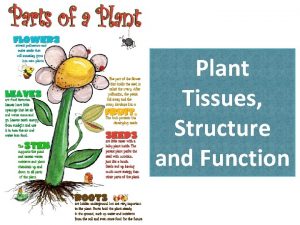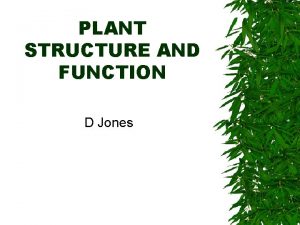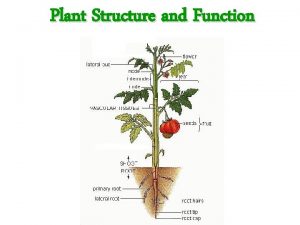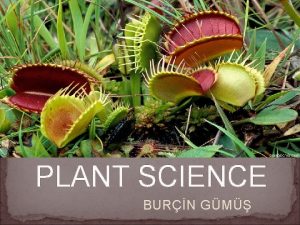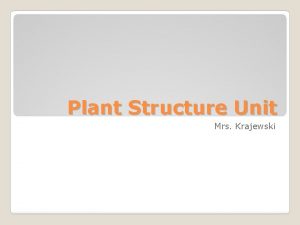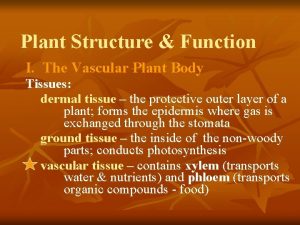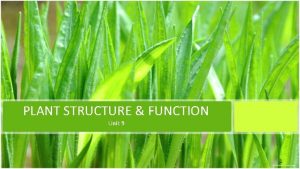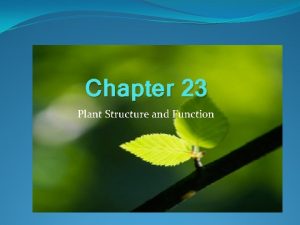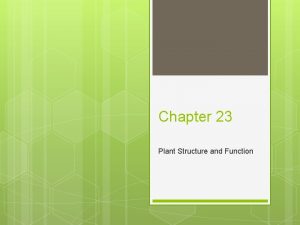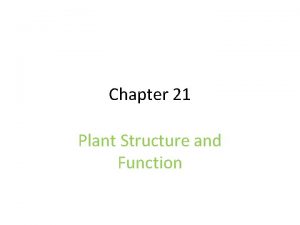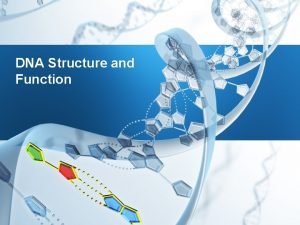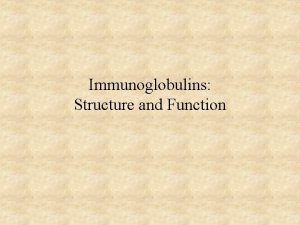Chapter 23 Plant Structure and Function Section 23




























































- Slides: 60

Chapter 23 Plant Structure and Function

Section 23 -1 Specialized Tissues in Plants

Structure of a Seed Plant 3 organs -> roots, stems, leaves Linked by tissues that provide support, protection, nutrient production and transport

Structure of a Seed Plant Roots Anchor plants, prevent erosion, absorb nutrients/water and transport them, store food, hold plants upright Stems Produce leaves/reproductive structures, contain transport systems Leaves Photosynthesis, have adjustable pores to reduce water loss and help gas exchange

Plant Tissue Systems 3 main tissue systems -> dermal, vascular, and ground Dermal Tissue - protective, outer covering Single cell layer in young plants called epidermis, the outer surface often covered with a waxy cuticle In older plants usually many layers, sometimes covered with bark Some epidermal cells have trichomes, which protect leaves and give them a fuzzy appearance In roots, incudes root hairs to absorb water

Plant Tissue Systems Vascular Tissues – support plant bodies, transport water and nutrients Xylem – transports water Phloem – transports products of photosynthesis

Xylem Cells called tracheids As they mature, they die and leave their cell walls which contain lignin (gives wood strength) Cells have connecting openings for water to pass Pits allow water to diffuse into ground tissue

Xylem Angiosperms have second xylem tissue called vessel elements – wider than tracheids, arranged end to end Mature and die, cell walls develop slits at each end for water to move freely

Phloem Alive at maturity Main cells called sieve tube elements, arranged end to end forming sieve tubes Small holes at ends so nutrients can move from cell to cell Lose nuclei and most organelles as they mature

Phloem Companion cells surround sieve tube elements - keep nuclei/organelles

Plant Tissue Systems Ground tissue – produces/stores sugars, contributes to physical support Parenchyma cells – thin walls, large central vacuole surrounded by thin layer of cytoplasm – chloroplasts in leaves Collenchyma cells – thicker walls, flexible, provide support Sclerenchyma cells - thickest walls, rigid, makes up seed coat

Parenchyma Collenchyma Sclerenchyma

Plant Growth and Meristems – regions of unspecialized cells in which mitosis produces new cells ready for differentiation Apical meristems found in places of rapid division – tips of stems and roots

Plant Growth and Meristems At first, cells produced in apical meristems are all thin, unspecialized Gradually mature and differentiate to form each tissue system Meristems also create highly specialized cells of cones and flowers Patterns of gene expression changes the stem’s apical meristem

Section 23 -2 Roots

Root Structure and Growth As soon as a seed sprouts, its first root brings in water/nutrients from soil Cells divide rapidly, pushing root tips into soil, providing raw materials for developing stems and leaves

Root Structure and Growth Taproot Systems Primary root grows long and thick (taproot) giving rise to smaller branches Can store sugars and starches Fibrous Begin Root Systems with one primary root, which is replaced by many equally sized branches that grow separately from the base of the stem Help prevent soil erosion

Dandelion (taproot) Grass (fibrous root)

Anatomy of a Root Epidermis made of dermal tissue – protection and absorption Surface covered in root hairs – penetrate between soil particles and increase surface area Cortex composed of ground tissue Water/minerals move from epidermis Stores products of photosynthesis and starches

Anatomy of a Root Endodermis – layer of ground tissue enclosing vascular cylinder – moves water and minerals to center of root Vascular cylinder in the center composed of xylem and phloem Dicot roots have central column of xylem

Anatomy of a Root Apical meristems near root tip allow roots to increase in length Root cap protects meristem, secretes slippery substance to ease progress through soil Cells at tip scraped away and replaced continually


Root Functions Uptake Soil of plant nutrients contains sand, silt, clay, air, bits of decaying animal/plant tissue in varying amounts Plants need inorganic nutrients like nitrogen, phosphorus, potassium, magnesium, calcium Trace elements also important, but excessive amounts can be toxic


Root Functions Active transport of dissolved nutrients Active transport proteins in root hairs, other epidermal cells Bring in mineral ions from soil Water movement by osmosis Mineral ions accumulate in root, water “follows”


Root Functions Movement Move into vascular cylinder through cortex Cylinder enclosed by endodermis – cells meet and cell walls from waterproof zone called Casparian strip forces water/minerals to move through cell membrane rather than between cells – filter and control water Ensures one-way flow

Root Functions Root pressure Minerals pumped into vascular cylinder, water follows by osmosis creating pressure Water has to go up - root pressure forces water through vascular cylinder into the xylem Up and up!

Section 23 -3 Stems

Stem Function Produce leaves, branches and flowers Hold leaves up to sun Transport substances Xylem and phloem form continuous tubes from roots to stems to leaves In many plants they function in storage and aid in photosynthesis

Anatomy of a Stem Surrounded by layer of epidermal cells with thick cell walls and a waxy protective coating

Anatomy of a Stem Growing stems have nodes where leaves are attached Buds contain apical meristems to produce new stems and leaves Larger plants have woody stems to support leaves and flowers

Monocot Stems Vascular bundles (clusters of xylem and phloem) scattered throughout ground tissue composed mainly of parenchyma cells

Dicot Stems Vascular bundles arranged in a ring pattern Parenchyma cells inside ring called pith, outside form cortex Complexity increases as stem increases in diameter

Primary Growth Occurs in all seed plants – apical meristems increase plant length

Secondary Growth Larger plants require older parts of stem to increase in thickness Common in dicots and gymnosperms

Secondary Growth Takes place in meristems called vascular cambium (produced vascular tissues, increase thickness of stem) and cork cambium (outer covering)

Growth from Vascular Cambium Thin layer of cells between xylem and phloem Xylem pushed in, phloem pushed out Increases diameter of stem each year

Wood Formation Layers of secondary xylem produces by vascular cambium Older xylem near center no longer carries water – heartwood (dark) Surrounded by sapwood – active in fluid transport (light)


Tree Rings In spring, vascular cambium produces light colored rings of xylem (early wood) Cells grow less as season continues, have thicker cells walls, darker in color (late wood) A ring = a year of growth Thick rings mean favorable weather

Formation of Bark Everything outside the vascular cambium in a mature stem (phloem, cork cambium, cork) Expansion leads to oldest tissue splitting Cork cambium surrounds cortex producing a thick layer of cork to prevent water loss Outer layers may flake off as stem thickens

Section 23 -4 Leaves

Anatomy of a Leaf Blade – thin, flat part of leaf – maximum light absorption Blade attached to stem by petiole Outer covering of dermal tissue Top and bottom covered by epidermis, tough irregular cells with thick outer walls Covered by waxy cuticle – waterproof, prevents water loss

Anatomy of a Leaf Vascular tissues bundles into veins that run from stem through leaf Palisade mesophyll beneath upper epidermis – closely packed cells that absorb sunlight Spongy mesophyll contains air spaces connected to stomata – small opening in epidermis allowing for gas exchange


Transpiration Mesophyll cell walls moist for easy diffusion Water can evaporate from these surfaces by transpiration May be replaced by water from xylem Cools leaves on hot days, but can threaten survival

Gas Exchange gases between air spaces in spongy mesophyll and exterior by opening stomata

Homeostasis If stomata were always open, too much water would be lost to transpiration Open just enough to allow photosynthesis Guard cells control opening and closing of stomata, regulating movement of gases

Homeostasis When water is abundant, increaser in water pressure in guard cells opens stoma by curving When water is scarce, water pressure in guard cells drops and stoma closes Stomata usually open during day, closed at night Can be closed in bright sunlight or hot/dry conditions Respond to environment

Transpiration and Wilting Osmotic pressure keeps leaves/stems rigid Water loss due to transpiration can lead to a loss of pressure in the cells

Adaptations of Leaves Pitcher plant – attract/digest insects to obtain nitrogen Living stone (rock plant) – 2 leaves for hot/dry conditions are round to minimize exposure to air, have very few stomata Spruce – waxy epidermis, stomata sunken below leaf surface Cactus – photosynthesis occurs in stems, leaves are thorns

Section 23 -5 Transport in Plants

Water Transport Combination of transpiration and capillary action moves water through xylem Water evaporates through stomata, leaf dries out, water is pulled up through xylem

How Cell Walls Pull Water Upward Water molecules attracted to each other by cohesion – H bonds form between molecules Water molecules bond to other substances by adhesion

How Cell Walls Pull Water Upward Capillary action is the tendency of water to rise in a thin tube because of cohesion and adhesion Thinner tube, higher water will rise

Putting it All Together Xylem tissue hollow, connected tubes (tracheids and vessel elements Tubes are lined with cellulose cell walls (adhesion) Transpiration removes water from the exposed walls, adhesion pulls water from interior of leaf Pull is powerful - extends down through tips of roots to the water in the soil

Nutrient Transport Pressure-flow 1. 2. 3. hypothesis Membranes of sieve tube cells use active transport to move sugars from cytoplasm into sieve tube itself Water follows by osmosis, creating pressure at the source of the sugars If a plant region has a need for sugars, they are actively pumped out of the tube and into the tissue water leaves the tube via osmosis, reducing the pressure

Nutrient Transport Flow of nutrient-rich fluid from the sources of sugars (source cells) to the places where sugars are used or stored (sink cells) Flexibility in changing seasons

 Chapter 22 plant structure and function answer key
Chapter 22 plant structure and function answer key Chapter 21 plant structure and function
Chapter 21 plant structure and function Chapter 23 plant structure and function
Chapter 23 plant structure and function Chapter 7 cell structure and function section review 7-2
Chapter 7 cell structure and function section review 7-2 Animal vs plant cell venn diagram
Animal vs plant cell venn diagram Chapter 21 section 1 plant evolution and adaptations
Chapter 21 section 1 plant evolution and adaptations Chapter 21 section 1 plant evolution and adaptations
Chapter 21 section 1 plant evolution and adaptations Chapter 35 plant structure growth and development
Chapter 35 plant structure growth and development Primary growth and secondary growth in plants
Primary growth and secondary growth in plants Cellular structure and function section 4 answer key
Cellular structure and function section 4 answer key Tronsmo plant pathology and plant diseases download
Tronsmo plant pathology and plant diseases download Tronsmo plant pathology and plant diseases download
Tronsmo plant pathology and plant diseases download Albugo eye
Albugo eye Sem vi
Sem vi Plant introduction in plant breeding
Plant introduction in plant breeding Plant introduction in plant breeding
Plant introduction in plant breeding Chapter 10 body structure and function
Chapter 10 body structure and function Biology chapter 7 cell structure and function
Biology chapter 7 cell structure and function Chapter 5 cell structure and function
Chapter 5 cell structure and function Chapter 7 membrane structure and function
Chapter 7 membrane structure and function Chapter 5 the structure and function of macromolecules
Chapter 5 the structure and function of macromolecules Chapter 7 membrane structure and function
Chapter 7 membrane structure and function Chapter 7 membrane structure and function
Chapter 7 membrane structure and function Chapter 7 membrane structure and function
Chapter 7 membrane structure and function Chapter 10 section 1 meiosis
Chapter 10 section 1 meiosis Parts of the plants
Parts of the plants Plant structure growth and development
Plant structure growth and development Chapter 4 section 2 the structure of atoms
Chapter 4 section 2 the structure of atoms Struktur organisasi laundry department
Struktur organisasi laundry department School structure definition
School structure definition Root and shoot system
Root and shoot system Flower foldable
Flower foldable Perfoliate leaf example
Perfoliate leaf example 3 parts of seeds
3 parts of seeds Bloody chlorophyll
Bloody chlorophyll Cell wall function
Cell wall function What is the main function of xylem within a plant brainpop
What is the main function of xylem within a plant brainpop Cytoplasm function in plant cell
Cytoplasm function in plant cell Endoplasmic reticulum function in plant cell
Endoplasmic reticulum function in plant cell What is the function of a stem in a plant
What is the function of a stem in a plant Leaves function plant
Leaves function plant Example of half section
Example of half section What is the definition of chemical potential energy
What is the definition of chemical potential energy Chapter 25 plant responses and adaptations answer key
Chapter 25 plant responses and adaptations answer key Positive geotropism
Positive geotropism Chapter 10 property plant and equipment
Chapter 10 property plant and equipment Plant and intangible assets chapter 9
Plant and intangible assets chapter 9 Seed germination
Seed germination Plant and intangible assets chapter 9
Plant and intangible assets chapter 9 Function of leaf guard cells
Function of leaf guard cells Diagram of monocot seed
Diagram of monocot seed Plant ground tissue
Plant ground tissue Function of frond
Function of frond Animal cell under electron microscope
Animal cell under electron microscope Cutin
Cutin Seed plant structure
Seed plant structure Plant
Plant Moss under microscope labeled
Moss under microscope labeled Phytomere
Phytomere Eukaryotic plant
Eukaryotic plant Which organelle
Which organelle

